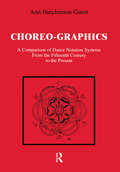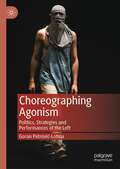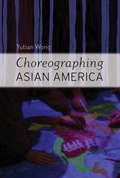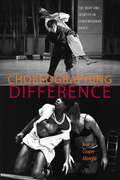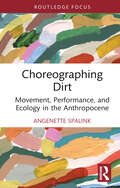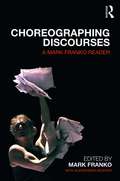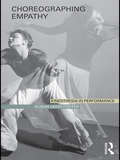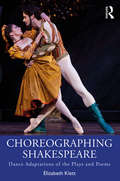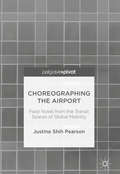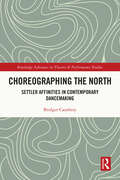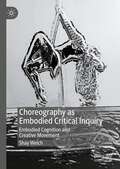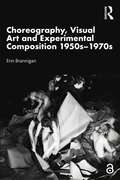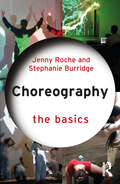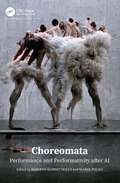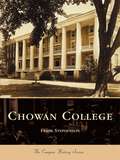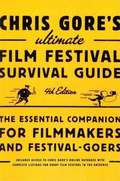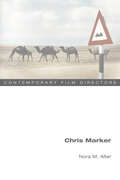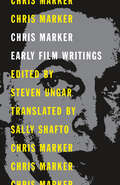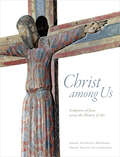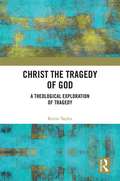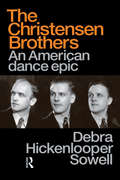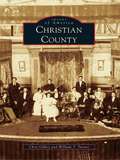- Table View
- List View
Choreographics: A Comparison of Dance Notation Systems from the Fifteenth Century to the Present
by Ann Hutchinson GuestHere for the first time is an account of how each of thirteen historical as well as present-day systems cope with indicating body movement, time, space (direction and level) and other basic movement aspects of paper. A one-to-one comparison is made of how the same simple patterns, such as walking, jumping, turning, etc. are notated in each system.
Choreographing Agonism: Politics, Strategies and Performances of the Left
by Goran Petrović-LotinaIn Choreographing Agonism, author Goran Petrović Lotina offers new insight into the connections between politics and performance. Exploring the political and philosophical roots of a number of recent leftist civil movements, Petrović Lotina forcefully argues for a re-imagining of artistic performance as an instrument of democracy capable of contesting a dominant politics.Inspired by post-Marxist theories of discourse theory, hegemony, conflict, and pluralism, and using tension as a guiding philosophical, political, and artistic force, the book expands the politico-philosophical debate on theories of performance. It offers both scholars and practitioners of performance a thought-provoking analysis of the ways in which artistic performance can be viewed politically as ‘agonistic choreo-political practice,’ a powerful strategy for mobilising alternative ways of living together and invigorating democracy.Choreographing Agonism makes a bold and innovative contribution to the discussion of political and philosophical thought in the field of Performance Studies.
Choreographing Asian America
by Yutian WongPoised at the intersection of Asian American studies and dance studies, Choreographing Asian America is the first book-length examination of the role of Orientalist discourse in shaping Asian Americanist entanglements with U.S. modern dance history. Moving beyond the acknowledgement that modern dance has its roots in Orientalist appropriation, Yutian Wong considers the effect that invisible Orientalism has on the reception of work by Asian American choreographers and the conceptualization of Asian American performance as a category. Drawing on ethnographic and choreographic research methods, the author follows the work of Club O' Noodles--a Vietnamese American performance ensemble--to understand how Asian American artists respond to competing narratives of representation, aesthetics, and social activism that often frame the production of Asian American performance.
Choreographing Difference: The Body and Identity in Contemporary Dance
by Ann Cooper AlbrightThe choreographies of Bill T. Jones, Cleveland Ballet Dancing Wheels, Zab Maboungou, David Dorfman, Marie Chouinard, Jawole Willa Jo Zollar, and others, have helped establish dance as a crucial discourse of the 90s. These dancers, Ann Cooper Albright argues, are asking the audience to see the body as a source of cultural identity -- a physical presence that moves with and through its gendered, racial, and social meanings.Through her articulate and nuanced analysis of contemporary choreography, Albright shows how the dancing body shifts conventions of representation and provides a critical example of the dialectical relationship between cultures and the bodies that inhabit them. As a dancer, feminist, and philosopher, Albright turns to the material experience of bodies, not just the body as a figure or metaphor, to understand how cultural representation becomes embedded in the body. In arguing for the intelligence of bodies, Choreographing Difference is itself a testimonial, giving voice to some important political, moral, and artistic questions of our time.Ebook Edition Note: All images have been redacted.
Choreographing Dirt: Movement, Performance, and Ecology in the Anthropocene (Routledge Studies in Theatre, Ecology, and Performance)
by Angenette SpalinkThis book is an innovative study that places performance and dance studies in conversation with ecology by exploring the significance of dirt in performance. Focusing on a range of 20th- and 21st-century performances that include modern dance, dance-theatre, Butoh, and everyday life, this book demonstrates how the choreography of dirt makes biological, geographical, and cultural meaning, what the author terms "biogeocultography". Whether it’s the Foundling Father digging into the earth’s strata in Suzan-Lori Park’s The America Play (1994), peat hurling through the air in Pina Bausch’s The Rite of Spring (1975), dancers frantically shovelling out fistfuls of dirt in Eveoke Dance Theatre’s Las Mariposas (2010), or Butoh performers dancing with fungi in Iván-Daniel Espinosa’s Messengers Divinos (2018), each example shows how the incorporation of dirt can reveal micro-level interactions between species – like the interplay between microscopic skin bacteria and soil protozoa – and macro-level interactions – like the transformation of peat to a greenhouse gas. By demonstrating the stakes of moving dirt, this book posits that performance can operate as a space to grapple with the multifaceted ecological dilemmas of the Anthropocene. This book will be of broad interest to both practitioners and researchers in theatre, performance studies, dance, ecocriticism, and the environmental humanities.
Choreographing Discourses: A Mark Franko Reader
by Mark FrankoChoreographing Discourses brings together essays originally published by Mark Franko between 1996 and the contemporary moment. Assembling these essays from international, sometimes untranslated sources and curating their relationship to a rapidly changing field, this Reader offers an important resource in the dynamic scholarly fields of Dance and Performance Studies. What makes this volume especially appropriate for undergraduate and graduate teaching is its critical focus on twentieth- and twenty-first-century dance artists and choreographers – among these, Oskar Schlemmer, Merce Cunningham, Kazuo Ohno, William Forsythe, Bill T. Jones, and Pina Bausch, some of the most high-profile European, American, and Japanese artists of the past century. The volume’s constellation of topics delves into controversies that are essential turning points in the field (notably, Still/Here and Paris is Burning), which illuminate the spine of the field while interlinking dance scholarship with performance theory, film, visual, and public art. The volume contains the first critical assessments of Franko’s contribution to the field by André Lepecki and Gay Morris, and an interview incorporating a biographical dimension to the development of Franko’s work and its relation to his dance and choreography. Ultimately, this Reader encourages a wide scope of conversation and engagement, opening up core questions in ethics, embodiment, and performativity.
Choreographing Empathy: Kinesthesia in Performance
by Susan Foster"This is an urgently needed book � as the question of choreographing behavior enters into realms outside of the aesthetic domains of theatrical dance, Susan Foster writes a thoroughly compelling argument." � Andr�epecki, New York University"May well prove to be one of Susan Foster�s most important works." � Ramsay Burt, De Montford University, UKWh
Choreographing Intersubjectivity in Performance Art (New World Choreographies)
by Victoria Wynne-JonesThis book offers new ways of thinking about dance-related artworks that have taken place in galleries, museums and biennales over the past two decades as part of the choreographic turn. It focuses on the concept of intersubjectivity and theorises about what happens when subjects meet within a performance artwork. The resulting relations are crucial to instances of performance art in which embodied subjects engage as spectators, participants and performers in orchestrated art events. Choreographing Intersubjectivity in Performance Art deploys a multi-disciplinary approach across dance choreography and evolving manifestations of performance art. An innovative, overarching concept of choreography sustains the idea that intersubjectivity evolves through places, spaces, performance and spectatorship. Drawing upon international examples, the book introduces readers to performance art from the South Pacific and the complexities of de-colonising choreography. Artists Tino Sehgal, Xavier Le Roy, Jordan Wolfson, Alicia Frankovich and Shigeyuki Kihara are discussed.
Choreographing Problems: Expressive Concepts in Contemporary Dance and Performance (Performance Philosophy)
by Bojana CvejićThis book illuminates the relationship between philosophy and experimental choreographic practice today in the works of leading European choreographers. A discussion of key issues in contemporary performance from the viewpoint of Deleuze, Spinoza and Bergson is accompanied by intricate analyses of seven groundbreaking dance performances.
Choreographing Shakespeare: Dance Adaptations of the Plays and Poems
by Elizabeth KlettChoreographing Shakespeare presents a hitherto unexplored history of the choreographers and performers who have created dance adaptations of Shakespeare. This book investigates forty dance works in genres such as ballet, modern dance, and hip-hop, produced between 1940 and 2016 by choreographers in Britain, America, and Europe, all of which use Shakespeare’s plays and Sonnets as their source material. By combining scholarly analysis of these productions with practice-based conversations from six contemporary choreographers, Klett offers both breadth of coverage and in-depth analysis of how Shakespeare’s poetic language is translated into the usually wordless medium of dance, and shows exactly how these dance adaptations move beyond the Shakespearean texts to engage with musical and choreographic influences. Ideal for students of Shakespeare and Dance Studies, Choreographing Shakespeare explores how dance adaptations strive to design legible and intelligible stories, while ultimately celebrating the beauty of pure movement.
Choreographing the Airport: Field Notes from the Transit Spaces of Global Mobility
by Justine Shih PearsonThis book investigates the global hub airport as an exemplar of cosmopolitan culture and space. A machine made for movement, itself perched at the crossroads of the world's incessant mobility, the airport is both a symbol of and stage for the ways in which we construct and inhabit the world today. Taking an ethnographically-inflected approach, this study brings together knowledge of the moving body from dance and performance and the study of systems of mobility within cultural and mobilities studies, in order to call attention to the kinaesthetic experience of global space. What is the choreography of the global airport? How does it perform on us. How do we perform within it? Extending thinking about contemporary cosmopolitanism and cultural identity, and the performativity of places and identities, this book is essential reading for those interested in cultural debates around globalisation, the innovative application of performance theory towards everyday experience, and interdisciplinary methodologies.
Choreographing the North: Settler Affinities in Contemporary Dancemaking (Routledge Advances in Theatre & Performance Studies)
by Bridget CautheryChoreographing the North examines 11 contemporary dance pieces that perform northern culture, landscape, folklore, and ideas of "North."The choreographers, from Canada, the United States, the United Kingdom, Belgium, Luxembourg, Australia, and Argentina, translate their real or imagined journeys to the North for stage and/or screen. This book examines the ways Indigenous subjects and subjectivities have been diminished and/or distorted and considers how that diminishment has fuelled misrepresentation both inside and outside the field of contemporary dance. Where Indigenous presence is represented in dances about the North, it is as discarnate storytellers or “everyman” pastoral figures against backdrops of ice and snow. Indigenous presence is there but it is romanticized, caricatured, flattened. Using these works as moving texts Cauthery argues that, in many regards, these dances are colonizing acts that either ignore or erase the land and people upon which they are based. In analyzing and deconstructing these dances, this book acknowledges the land- and culture-based inheritances embedded in and performed through the works themselves.This study will be of great interest to students and scholars in dance studies, theatre and performance studies, and cultural studies, as well as those interested in environmental psychology, human geography, and the expanding field of Arctic humanities.
Choreography as Embodied Critical Inquiry: Embodied Cognition and Creative Movement
by Shay WelchIn this book, Shay Welch expands on the contemporary cognitive thinking-in-movement framework, which has its roots in the work of Maxine Sheets-Johnstone but extends and develops within contemporary embodied cognition theory. Welch believes that dance can be used to ask questions, and this book offers a method of how critical inquiry can be embodied. First, she presents the theoretical underpinnings of what this process is and how it can work; second, she introduces the empirical method as a tool that can be used by movers for the purpose of doing embodied inquiry. Exploring the role of embodied cognition and embodied metaphors in mining the body for questions, Welch demonstrates how to utilize movement to explore embodied practices of knowing. She argues that our creative embodied movements facilitate our ability to bodily engage in critical analysis about the world.
Choreography, Visual Art and Experimental Composition 1950s–1970s
by Erin BranniganThis book traces the history of engagements between dance and the visual arts in the mid-twentieth century and provides a backdrop for the emerging field of contemporary, intermedial art practice. Exploring the disciplinary identity of dance in dialogue with the visual arts, this book unpacks how compositional methods that were dance-based informed visual art contexts. The book provokes fresh consideration of the entangled relationship between, and historiographic significance of, visual arts and dance by exploring movements in history that dance has been traditionally mapped to (Neo-Avant Garde, Neo-Dada, Conceptual art, Postmodernism, and Performance Art) and the specific practices and innovations from key people in the field (like John Cage, Anna Halprin, and Robert Rauschenberg). This book also employs a series of historical and critical case studies which show how compositional approaches from dance—breath, weight, tone, energy—informed the emergence of the intermedial. Ultimately this book shows how dance and choreography have played an important role in shaping visual arts culture and enables the re-imagination of current art practices through the use of choreographic tools. This unique and timely offering is important reading for those studying and researching in visual and fine arts, performance history and theory, dance practice and dance studies, as well as those working within the fields of dance and visual art.
Choreography: The Basics (The Basics)
by Stephanie Burridge Jenny RocheThis book provides a comprehensive and concise overview of choreography both as a creative skill and as a field of study, introducing readers to the essential theory and context of choreographic practice. Providing invaluable practical considerations for creating choreography as well as leading international examples from a range of geographical and cultural contexts, this resource will enhance students’ knowledge of how to create dance. This clear guide outlines both historical and recent developments within the field, including how choreographers are influenced by technology and intercultural exchange, whilst also demonstrating the potential to address social, political and philosophical themes. It further explores how students can devise and analyse their own work in a range of styles, how choreography can be used in range of contexts – including site-specific work and digital technologies – and engages with communities of performers to give helpful, expert suggestions for developing choreographic projects. This book is a highly valuable resource for anyone studying dancemaking, dance studies or contemporary choreographic practice and those in the early stages of dance training who wish to pursue a career as a choreographer or in a related profession.
Choreomata: Performance and Performativity after AI
by Roberto Alonso TrilloIs artificial intelligence (AI) becoming more and more expressive, or is human thought adopting more and more structures from computation? What does it mean to perform oneself through AI, or to construct one’s subjectivity through AI? How does AI continue to complicate what it means to have a body? Has the golden age of AI, especially with regards to creative applications, already ended? Choreomata: Performance and Performativity after AI is a book about performance and performativity, but more specifically, it is a book about the performance of artificiality and the performance of intelligence. Both humans and human-designed computational forces are thoroughly engaged in an entangled, mutual performance of AI. Choreomata spins up a latticework of interdisciplinary thought, pairing theoretical inquiry from philosophy, information theory, and computer science with practical case studies from visual art, dance, music, and social theory. Through cross-disciplinary proportions and a diverse roster of contributors, this book contains insights for computer scientists, social scientists, industry professionals, artists, and beyond.
Chowan College
by Frank StephensonLocated in the picturesque northeastern corner of North Carolina in Murfreesboro and Hertford County, Chowan College is the second oldest of the state's Baptist colleges. Founded in 1848, the school began as Chowan Baptist Female Institute and did not begin admitting male students until 1931, almost a century after its opening. In 1937, the Great Depression forced the school to become a two-year junior college, but it regained four-year status in 1992. Since then, Chowan College has enjoyed a myriad of successes, including being named one of the South's premier third-tier comprehensive colleges and ranked ninth in terms of diversity by U.S. News and World Report. Recognized for such programs as elementary education, graphic communications, and environmental science, Chowan College is truly one of the South's hidden treasures.The black-and-white images in Chowan College trace the vast history of the school's existence, while also capturing the natural beauty of the campus. Through the vintage photographs and accompanying narrative, Chowan College's tradition unfolds-providing a detailed glimpse of the institution's athletic, extracurricular, social, and aesthetic history. This pictorial chronicle also showcases the architecture of the campus and displays the familiar faces of Chowan's past.
Chris Gore's Ultimate Film Festival Survival Guide: The Essential Companion for Filmmakers and Festival-Goers (Fourth Edition)
by Chris GoreThe guerrilla guide to marketing and selling an indie film. Some people are just there for the loot bags. But most of the people at a film festival are trying to market and sell an independent film. Don't be just one of the horde. Use Chris Gore's Ultimate Film Festival Survival Guide to help your indie film stand out! Entertainment Weekly loves Gore's book, calling it a "treatise on schmoozing, bullying, and otherwise weaseling one's way into the cinematic madness known as film festivals." The newly revised and updated fourth edition includes full listings for more than 1,000 film festivals, with complete tips and contact information, plus in-depth analysis of the Big Ten festivals. With detailed, fresh how-tos for marketing, distributing, and selling a film and using websites to build buzz, plus interviews with top festival filmmakers, step-by-steps on what to do after your film gets accepted, and explanations of how to distribute a film, Chris Gore's guide tells filmmakers exactly how to become a player in the indie world. Chris Gore's Ultimate Film Festival Survival Guide includes complete listings for more than 1,000 festivals--find the best for indie, documentary, short, student, digital, and animation, and a CD-ROM!
Chris Marker (Contemporary Film Directors)
by Nora M. AlterThe maverick filmmaker's personal and political relationships with film Best known in the United States for his visionary short film La Jetée, Chris Marker spearheaded the bourgeoning Nouvelle Vague scene in the late 1950s. His distinctive style and use of still images place him among the postwar era's most influential European filmmakers. His fearless political cinema, meanwhile, provided a bold model for other activist filmmakers. Nora M. Alter investigates the core themes and motivations behind an unpredictable and transnational career that defies easy classification. A photographer, multimedia artist, writer, broadcaster, producer, and organizer, Marker cultivated an artistic dynamism and always-changing identity. ""I am an essayist,"" Marker once said, and his 1953 debut filmic essay The Statues Also Die (with Alain Resnais) exposed the European art market's complicity in atrocities in the former Belgian Congo. Ranging geographically as well as artistically, Marker's travels led to films like the classic Sans Soleil and Sunday in Peking. His decades-long struggle against global injustice involved him with Night and Fog, Le Joli Mai, Far from Vietnam, Le fond du l'air est Rouge, and Prime Time in the Camps. Insightful and revealing, Chris Marker includes interviews with the notoriously private director.
Chris Marker: Early Film Writings
by Chris MarkerFormative writings by French avant-garde filmmaker Chris Marker It is hard to imagine French cinema without La Jetée (1962), the time-travel short feature by the reclusive French filmmaker Christian François Bouche-Villeneuve, better known as Chris Marker. He not only influenced artists ranging from David Bowie to J. G. Ballard but also inspired the cult film 12 Monkeys. Marker&’s influence expanded beyond his own films through his writings for the French monthly Esprit as well as anthologies and newly founded film publications. This first English translation of Marker&’s early writings on film brings together reviews and essays, published between 1948 and 1955, that span the topics of film style, adaptation, and ideology, as well as animation and the debates surrounding 3-D and wide-screen technologies, ranging from late silent-era films to postwar Hollywood&’s efforts to contend with the rise of television. Readers will find commentary on Laurence Olivier&’s 1944 screen adaptation of Henry V, a scathing review of Robert Montgomery&’s Lady in the Lake (1947), critiques of Walt Disney productions, a discussion of the pitfalls of prioritizing commercial success over aesthetic values, and more. An indispensable resource for cinephiles and scholars alike, these texts document the emergence of Marker&’s critical voice and situate him alongside such contemporaries as André Bazin and Eric Rohmer, as well as the future French New Wave figures Jean-Luc Godard and François Truffaut. They show how his remarks on individual films open onto his engagement with films as social and cultural phenomena.
Christ among Us: Sculpted Images of Jesus from across the History of Art
by Joseph Antenucci Becherer Henry Martin LuttikhuizenNo single figure has been more often featured in Western art than Jesus Christ. Sculptures, particularly—though they have received less notice than paintings—provide some of the most moving representations in their capacity to show Christ alongside us in three-dimensional space.In this &“catalog for an imagined exhibition,&” two prominent art historians—one from the Roman Catholic tradition, one from the Protestant tradition—offer a guided tour of fifty-two sculptures of Jesus Christ from throughout the Western world. The chronological scope of the selection ranges from the third century to the present, with the work of well-known sculptors featured alongside the work of less familiar artists who deserve more attention.Along with lush, high-resolution photographs, each piece is accompanied by an essay that places it in context and brings it to life, so readers can experience the sculpture almost as vividly as they would in person. Those interested in devotional as well as artistic significance will find inspiration in the striking representations of Christ in his many forms: healer, sage, sovereign, and savior, from his humble yet majestic birth to his harrowing death and miraculous resurrection.
Christ the Tragedy of God: A Theological Exploration of Tragedy
by Kevin TaylorTragedy is a genre for exploring loss and suffering, and this book traces the vital areas where tragedy has shaped and been a resource for Christian theology. There is a history to the relationship of theology and tragedy; tragic literature has explored areas of theological interest, and is present in the Bible and ongoing theological concerns. Christian theology has a long history of using what is at hand, and the genre of tragedy is no different. What are the merits and challenges of placing the central narrative of the passion, death and resurrection of Christ in tragic terms? This study examines important and shared concerns of theology and tragedy: sacrifice and war, rationality and order, historical contingency, blindness, guilt, and self-awareness. Theologians such as Reinhold Niebuhr, Hans Urs von Balthasar, Martin Luther King Jr., Simone Weil, and Boethius have explored tragedy as a theological resource. The historical relationship of theology and tragedy reveals that neither is monolithic, and both remain diverse and unstable areas of human thought. This fascinating book will be of keen interest to theologians, as well as scholars in the fields of literary studies and tragic theory.
Christensen Brothers: An American Dance Epic (Choreography and Dance Studies Series #Vol. 16)
by Debra Hickenlooper SowellFirst Published in 1998. Routledge is an imprint of Taylor & Francis, an informa company.
Christian Art: A Very Short Introduction
by Beth WilliamsonThis Very Short Introduction decodes the key themes, signs, and symbols found l in Christian art: the Eucharist, the image of the Crucifixion, the Virgin Mary, the Saints, Old and New Testament narrative imagery, and iconography. It also explores the theological and historical background of Christian imagery, from the devotional works of the Medieval and Renaissance periods, to the twenty first century. Williamson uses examples from, among others, Cimabue, Michelangelo, and Rosetti. She concludes by outlining the co-existence in contemporary "post-Christian" culture of the deliberately controversial works of artists such as Andres Serrano and Chris Ofili, alongside the consciously devotional works of those such as Eric Gill and Peter Blake.
Christian County
by William T. Turner Chris GilkeyIn the years since Christian County was founded more than 210 years ago, the rural area--including many small communities and the county seat of Hopkinsville--has become a historic treasure of various architectural styles. Water-powered mills are representative of the first local industry. Blacksmith shops, followed by several small craft shops, preceded the largest 19th-century industry: the manufacturing of Mogul brand farm wagons. A plow factory and a butter manufacturing facility were also two of several short-lived industrial attempts to make a great financial success. Throughout the 20th century, changing social and economic growth brought the demolition of many priceless architectural examples. This title presents a close observation of many of these vanished landmarks, with old churches, public buildings, country stores, schools, and road toll gates providing a glimpse into the county's past.
